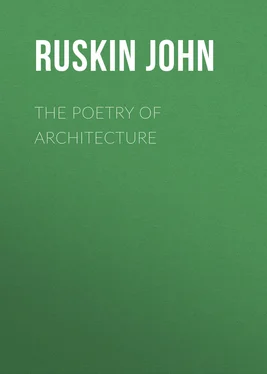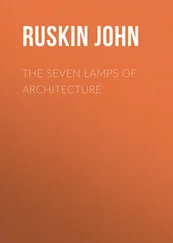John Ruskin - The Poetry of Architecture
Здесь есть возможность читать онлайн «John Ruskin - The Poetry of Architecture» — ознакомительный отрывок электронной книги совершенно бесплатно, а после прочтения отрывка купить полную версию. В некоторых случаях можно слушать аудио, скачать через торрент в формате fb2 и присутствует краткое содержание. Жанр: foreign_antique, foreign_home, literature_19, visual_arts, на английском языке. Описание произведения, (предисловие) а так же отзывы посетителей доступны на портале библиотеки ЛибКат.
- Название:The Poetry of Architecture
- Автор:
- Жанр:
- Год:неизвестен
- ISBN:нет данных
- Рейтинг книги:5 / 5. Голосов: 1
-
Избранное:Добавить в избранное
- Отзывы:
-
Ваша оценка:
- 100
- 1
- 2
- 3
- 4
- 5
The Poetry of Architecture: краткое содержание, описание и аннотация
Предлагаем к чтению аннотацию, описание, краткое содержание или предисловие (зависит от того, что написал сам автор книги «The Poetry of Architecture»). Если вы не нашли необходимую информацию о книге — напишите в комментариях, мы постараемся отыскать её.
The Poetry of Architecture — читать онлайн ознакомительный отрывок
Ниже представлен текст книги, разбитый по страницам. Система сохранения места последней прочитанной страницы, позволяет с удобством читать онлайн бесплатно книгу «The Poetry of Architecture», без необходимости каждый раз заново искать на чём Вы остановились. Поставьте закладку, и сможете в любой момент перейти на страницу, на которой закончили чтение.
Интервал:
Закладка:
34. III. Elegance of feeling. We never can prevent ourselves from imagining that we perceive in the graceful negligence of the Italian cottage, the evidence of a taste among the lower orders refined by the glory of their land, and the beauty of its remains. We have always had strong faith in the influence of climate on the mind, and feel strongly tempted to discuss the subject at length; but our paper has already exceeded its proposed limits, and we must content ourselves with remarking what will not, we think, be disputed, that the eye, by constantly resting either on natural scenery of noble tone and character, or on the architectural remains of classical beauty, must contract a habit of feeling correctly and tastefully; the influence of which, we think, is seen in the style of edifices the most modern and the most humble.
35. Lastly, Dilapidation. We have just used the term "graceful negligence": whether it be graceful, or not, is a matter of taste; but the uncomfortable and ruinous disorder and dilapidation of the Italian cottage is one of observation. The splendor of the climate requires nothing more than shade from the sun, and occasionally shelter from a violent storm: the outer arcade affords them both; it becomes the nightly lounge and daily dormitory of its inhabitant, and the interior is abandoned to filth and decay. Indolence watches the tooth of Time with careless eye and nerveless hand. Religion, or its abuse, reduces every individual of the population to utter inactivity three days out of the seven; and the habits formed in the three regulate the four. Abject poverty takes away the power, while brutish sloth weakens the will; and the filthy habits of the Italian prevent him from suffering from the state to which he is reduced. The shattered roofs, the dark, confused, ragged windows, the obscure chambers, the tattered and dirty draperies, altogether present a picture which, seen too near, is sometimes revolting to the eye, always melancholy to the mind. Yet even this many would not wish to be otherwise. The prosperity of nations, as of individuals, is cold and hard-hearted, and forgetful. The dead die, indeed, trampled down by the crowd of the living; the place thereof shall know them no more, for that place is not in the hearts of the survivors for whose interests they have made way. But adversity and ruin point to the sepulcher, and it is not trodden on; to the chronicle, and it doth not decay. Who would substitute the rush of a new nation, the struggle of an awakening power, for the dreamy sleep of Italy's desolation, for her sweet silence of melancholy thought, her twilight time of everlasting memories?
36. Such, we think, are the principal distinctive attributes of the Italian cottage. Let it not be thought that we are wasting time in the contemplation of its beauties; even though they are of a kind which the architect can never imitate, because he has no command over time, and no choice of situation; and which he ought not to imitate, if he could, because they are only locally desirable or admirable. Our object, let it always be remembered, is not the attainment of architectural data, but the formation of taste.
Oct. 12, 1837
III.
THE MOUNTAIN COTTAGE—SWITZERLAND
37. In the three instances of the lowland cottage which have been already considered, are included the chief peculiarities of style which are interesting or important. I have not, it is true, spoken of the carved oaken gable and shadowy roof of the Norman village; of the black crossed rafters and fantastic proportions which delight the eyes of the German; nor of the Moorish arches and confused galleries which mingle so magnificently with the inimitable fretwork of the gray temples of the Spaniard. But these are not peculiarities solely belonging to the cottage: they are found in buildings of a higher order, and seldom, unless where they are combined with other features. They are therefore rather to be considered, in future, as elements of street effect, than, now, as the peculiarities of independent buildings. My remarks on the Italian cottage might, indeed, be applied, were it not for the constant presence of Moorish feeling, to that of Spain. The architecture of the two nations is intimately connected: modified, in Italy, by the taste of the Roman; and, in Spain, by the fanciful creations of the Moor. When I am considering the fortress and the palace, 4I shall be compelled to devote a very large share of my attention to Spain; but for characteristic examples of the cottage, I turn rather to Switzerland and England. Preparatory, therefore, to a few general remarks on modern ornamental cottages, it will be instructive to observe the peculiarities of two varieties of the mountain cottage, diametrically opposite to each other in most of their features; one always beautiful, and the other frequently so.
38. First, for Helvetia. Well do I remember the thrilling and exquisite moment when first, first in my life (which had not been over long), I encountered, in a calm and shadowy dingle, darkened with the thick spreading of tall pines, and voiceful with the singing of a rock-encumbered stream, and passing up towards the flank of a smooth green mountain, whose swarded summit shone in the summer snow like an emerald set in silver; when, I say, I first encountered in this calm defile of the Jura, the unobtrusive, yet beautiful, front of the Swiss cottage. I thought it the loveliest piece of architecture I had ever had the felicity of contemplating; yet it was nothing in itself, nothing but a few mossy fir trunks, loosely nailed together, with one or two gray stones on the roof: but its power was the power of association; its beauty, that of fitness and humility.
39. How different is this from what modern architects erect, when they attempt to produce what is, by courtesy, called a Swiss cottage. The modern building known in Britain by that name has very long chimneys, covered with various exceedingly ingenious devices for the convenient reception and hospitable entertainment of soot, supposed by the innocent and deluded proprietor to be "meant for ornament." Its gable roof slopes at an acute angle, and terminates in an interesting and romantic manner, at each extremity, in a tooth-pick. Its walls are very precisely and prettily plastered; and it is rendered quite complete by the addition of two neat little bow windows, supported on neat little mahogany brackets, full of neat little squares of red and yellow glass. Its door is approached under a neat little veranda, "uncommon green," and is flanked on each side by a neat little round table, with all its legs of different lengths, and by a variety of neat little wooden chairs, all very peculiarly uncomfortable, and amazingly full of earwigs: the whole being surrounded by a garden full of flints, burnt bricks and cinders, with some water in the middle, and a fountain in the middle of it, which won't play; accompanied by some goldfish, which won't swim; and by two or three ducks, which will splash. Now, I am excessively sorry to inform the members of any respectable English family, who are making themselves uncomfortable in one of these ingenious conceptions, under the idea that they are living in a Swiss cottage, that they labor under a melancholy deception; and shall now proceed to investigate the peculiarities of the real building.
40. The life of a Swiss peasant is divided into two periods; that in which he is watching his cattle at their summer pasture on the high Alps, 5and that in which he seeks shelter from the violence of the winter storms in the most retired parts of the low valleys. During the first period, he requires only occasional shelter from storms of excessive violence; during the latter, a sufficient protection from continued inclement weather. The Alpine or summer cottage, therefore, is a rude log hut, formed of unsquared pine trunks, notched into each other at the corners. The roof being excessively flat, so as to offer no surface to the wind, is covered with fragments of any stone that will split easily, held on by crossing logs; which are in their turn kept down by masses of stone; the whole being generally sheltered behind some protecting rock, or resting against the slope of the mountain, so that, from one side, you may step upon the roof. That is the châlet . When well grouped, running along a slope of mountain side, these huts produce a very pleasing effect, being never obtrusive (owing to the prevailing grayness of their tone), uniting well with surrounding objects, and bestowing at once animation and character.
Читать дальшеИнтервал:
Закладка:
Похожие книги на «The Poetry of Architecture»
Представляем Вашему вниманию похожие книги на «The Poetry of Architecture» списком для выбора. Мы отобрали схожую по названию и смыслу литературу в надежде предоставить читателям больше вариантов отыскать новые, интересные, ещё непрочитанные произведения.
Обсуждение, отзывы о книге «The Poetry of Architecture» и просто собственные мнения читателей. Оставьте ваши комментарии, напишите, что Вы думаете о произведении, его смысле или главных героях. Укажите что конкретно понравилось, а что нет, и почему Вы так считаете.












